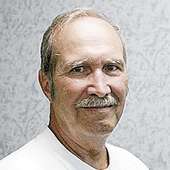- Missouri campgrounds resurgence (5/30/20)
- August a fantastic month for catfishing (8/11/18)
- Kayaking, canoeing good way to spend hot summer days (7/27/18)
- Hot weather means hot catfishing (7/7/18)
- Boat buyers have abundant options (6/16/18)
- Warm weather invites camping (6/9/18)
- Topwater fishing is a blast (6/2/18)
'Birding' interest peaks during winter months
Saturday, January 14, 2017

Redbirds and a blue jay wait their turn at a bird feeder after the recent snow. (Ken White/Special to the Daily Mail)
As we move into January, hunting seasons are winding down.
Archery deer and turkey season ends this weekend, as well as quail and pheasant seasons. However, more and more people are taking advantage of the winter months by feeding and watching the many species of birds that are around during the winter.
There are a growing number of people who get "birdy" this time of year. They don't hunt with a gun or bow, but use binoculars to find, watch and identify birds.
Jack Wilson, of Warsaw, is one of those growing number of birders. Wilson said, "Birding doesn't take much equipment, all you need is a quality pair of binoculars, a good bird identification book and a good printed field guide.
"Once you learn to recognize the bird's habitat along with their different traits, like feeding and flying, it becomes easy to determine different species. It gets to be a lot of fun and you can do it at your convenience."
Birders have been ready for the annual invasion of hungry birds as they've moved from places up north. The big invasion of birds from Canada's north woods delight feeder-watchers in our area. As cold winters in northern states send human "snowbirds" to the south, so will they likewise bring the real feathered friends to our areas this winter. This recent cold spell has done just that. Keeping the bird feeders busy by keeping their feeders full.
Wilson has taught many of his family and friends how to enjoy the birds. He gives this advise to beginners that should help get them started. Though it's as easy as putting up a bird feeder, he suggests they get a good pair of binoculars, one with 7x35 or 10x50 power for adequate magnification that will help when viewing the birds.
Field notes should include the date, location, weather conditions, bird behavior along with any unique markings such as bill shape or the curve of their wings.
Beginners should learn to identify birds by sight and sound. Knowing the shape of a bird's wings, legs, head and tail feathers makes it easier to identify what species they are. For example, hawks fly with rounded wings and falcons rely on more pointed wings. Pay attention to the bird's size as well.
Commit to memory prominent body markings. Stripes, eye markings and color patterns can help determine a bird's age and distinguish similar-looking species.
Familiarize yourself with birds favorite habitats. Habitat knowledge helps eliminate species not associated with a specific habitat or range.
Advanced birders know that it is imperative to learn bird songs, which can identify a species when the bird might be hidden in dense cover. Familiarize yourself with bird songs by chasing down each song until you discover its maker, or simply check out tape recordings at a library.
Wilson said he took his grandson on a trip to Truman Lake and they started counting the different species of birds they saw, and by the days end they had counted 11 different species including bald eagles. He said, "I think after that trip my grandson's interest in birding took a big step."
There are millions of birders in the country and many tons of bird feed that will be utilized throughout winter as birders watch the hungry birds enjoy their handouts.
A neighbor, who feeds the birds year-around, said he couldn't keep the feeders full during the nearly zero temperatures last month.
"It seemed that just a few minutes after I filled my feeders, I would look out and they were nearly empty. I counted eight different species of birds using the feeders."
Not only did Wilson see a lot of different species of birds close to home, he was checking on his boat at the lake ---- and while there, he saw ducks, geese, loons, two bald eagles and even a small flock of turkeys sailed over the cove nearby. He said, "Seeing all those big birds was something special."
James Davis, of Springfield, never thought it would be worth it to put out a bird feeder in his back yard. However, with the cold start to 2017, he decided to put out a small feeder and was surprised at the result.
"In less than two minutes after I put sunflower seeds in the feeder, there was several birds using it, and a few minutes later it had birds all around it. I didn't think there were that many birds in our neighborhood.
"Now the feeder is an attraction, not only to the birds, but also our grandchildren. I'm glad I started helping the birds through the winter."
He also suggest us to take advantage of Springfield's Nature Center. It is a great place to take walks, watch the birds, and get information on wildlife habitat. Of course, there are any number of places you can visit where you may receive valuable information on birding as well as observation points and places to go.
Bird watching and feeding has become a winter sport for many people from grandkids to grandparents.
Wilson said, "Once you get started, you will want to keep it up. It will surprise you just how much enjoyment you will get from learning more about our feathered friends."

